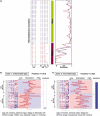Global genomic and RNA profiles for novel risk stratification of neuroblastoma
- PMID: 20731666
- PMCID: PMC11159775
- DOI: 10.1111/j.1349-7006.2010.01681.x
Global genomic and RNA profiles for novel risk stratification of neuroblastoma
Abstract
Neuroblastoma is one of the most common solid tumors in children. Its clinical behavior ranges widely from spontaneous regression to life-threatening aggressive growth. The molecular etiology of neuroblastoma is still enigmatic and the overall cure rate of advanced disease is still very poor. Recent microarray-based technology provided us with important information such as comprehensive genomic alterations and gene expression profiles to help us understand the molecular characteristics of each tumor in detail. Several retrospective studies have revealed that these signatures are strongly correlated with patient prognoses and led to the construction of new risk stratification systems, some of which are considered for evaluation in upcoming clinical studies in a prospective way. Large-scale analyses using a variety of genetic tools also discovered a major familial neuroblastoma predisposition gene ALK, as well as new candidate susceptibility genes at 6q22 and 2q35 for sporadic neuroblastoma. Of note, ALK is mutated in 6-9% of sporadic cases, and is either amplified or constitutively activated through mutations mainly within the kinase domain, promoting the possibility of new therapeutic strategies using ALK inhibitors. Additional candidates for outcome predictors such as the methylation phenotype of tumor DNA and expression profiles of microRNA have also been proposed. Such variety of information will help us understand the heterogeneity of neuroblastoma biology and further, the combined use of these signatures will be beneficial in predicting prognosis with high accuracy, as well as choosing a suitable therapy for the individual patient.
© 2010 Japanese Cancer Association.
Figures


Similar articles
-
Oncogenic mutations of ALK in neuroblastoma.Cancer Sci. 2011 Feb;102(2):302-8. doi: 10.1111/j.1349-7006.2010.01825.x. Cancer Sci. 2011. PMID: 21205076 Free PMC article. Review.
-
Identification of ALK as a major familial neuroblastoma predisposition gene.Nature. 2008 Oct 16;455(7215):930-5. doi: 10.1038/nature07261. Epub 2008 Aug 24. Nature. 2008. PMID: 18724359 Free PMC article.
-
Genome-wide linkage analysis to identify genetic modifiers of ALK mutation penetrance in familial neuroblastoma.Hum Hered. 2011;71(2):135-9. doi: 10.1159/000324843. Epub 2011 Jul 6. Hum Hered. 2011. PMID: 21734404 Free PMC article.
-
Activated Alk triggers prolonged neurogenesis and Ret upregulation providing a therapeutic target in ALK-mutated neuroblastoma.Oncotarget. 2014 May 15;5(9):2688-702. doi: 10.18632/oncotarget.1883. Oncotarget. 2014. PMID: 24811913 Free PMC article.
-
Advances in the understanding of constitutional and somatic genomic alterations in neuroblastoma.Cancer Genet. 2011 Mar;204(3):113-21. doi: 10.1016/j.cancergen.2011.03.001. Cancer Genet. 2011. PMID: 21504710 Review.
Cited by
-
CFC1 is a cancer stemness-regulating factor in neuroblastoma.Oncotarget. 2017 Jul 11;8(28):45046-45059. doi: 10.18632/oncotarget.18464. Oncotarget. 2017. PMID: 28620148 Free PMC article.
-
Genome-wide microarray expression and genomic alterations by array-CGH analysis in neuroblastoma stem-like cells.PLoS One. 2014 Nov 13;9(11):e113105. doi: 10.1371/journal.pone.0113105. eCollection 2014. PLoS One. 2014. PMID: 25392930 Free PMC article.
-
Bortezomib induces methylation changes in neuroblastoma cells that appear to play a significant role in resistance development to this compound.Sci Rep. 2021 May 10;11(1):9846. doi: 10.1038/s41598-021-89128-0. Sci Rep. 2021. PMID: 33972578 Free PMC article.
-
Growth, progression and chromosome instability of Neuroblastoma: a new scenario of tumorigenesis?BMC Cancer. 2017 Jan 5;17(1):20. doi: 10.1186/s12885-016-2986-6. BMC Cancer. 2017. PMID: 28056863 Free PMC article.
-
Neuroblastoma: issues in transplantation.Biol Blood Marrow Transplant. 2012 Jan;18(1 Suppl):S92-100. doi: 10.1016/j.bbmt.2011.10.020. Biol Blood Marrow Transplant. 2012. PMID: 22226119 Free PMC article. Review. No abstract available.
References
-
- Brodeur GM. Neuroblastoma: biological insight into a clinical enigma. Nat Rev Cancer 2003; 3: 203–16. - PubMed
-
- Maris JM. The biologic basis for neuroblastoma heterogeneity and risk stratification. Curr Opin Pediatr 2005; 17: 7–13. - PubMed
-
- Look AT, Hayes FA, Nitschke R, McWilliams NB, Green AA. Cellular DNA content as a predictor of response to chemotherapy in infants with unresectable neuroblastoma. N Engl J Med 1984; 311: 231–5. - PubMed
-
- Schwab M, Alitalo K, Klempnauer KH et al. Amplified DNA with limited homology to myc cellular oncogene is shared by human neuroblastoma cell lines and a neuroblastoma tumour. Nature 1983; 305: 245–8. - PubMed
-
- Brodeur GM, Seeger RC, Schwab M, Varmus HE, Bishop JM. Amplification of N‐myc in untreated human neuroblastomas correlates with advanced disease stage. Science 1984; 224: 1121–4. - PubMed
Publication types
MeSH terms
Substances
LinkOut - more resources
Full Text Sources
Medical

